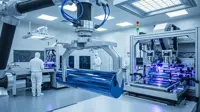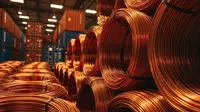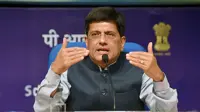Chips with self-assembling rectangles
By By David L. Chandler, MIT News Office | 19 Jul 2012
Researchers at MIT have developed a new approach to creating the complex array of wires and connections on microchips, using a system of self-assembling polymers. The work could eventually lead to a way of making more densely packed components on memory chips and other devices.
 |
| An artist's representation of the structures produced by this self-assembly method shows a top-down view, with the posts produced by electron-beam lithography shown in blue, and the resulting self-assembled shapes shown in white. Image: Yan Liang |
The new method - developed by MIT visiting doctoral student Amir Tavakkoli of the National University of Singapore, along with two other graduate students and three professors in MIT's departments of Electrical Engineering and Computer Science (EECS) and Materials Science and Engineering (DMSE) - is described in a paper to be published this August in the journal Advanced Materials; the paper is available online now.
The process is closely related to a method the same team described last month in a paper in Science, which makes it possible to produce three-dimensional configurations of wires and connections using a similar system of self-assembling polymers.
In the new paper, the researchers describe a system for producing arrays of wires that meet at right angles, forming squares and rectangles. While these shapes are the basis for most microchip circuit layouts, they are quite difficult to produce through self-assembly. When molecules self-assemble, explains Caroline Ross, the Toyota Professor of Materials Science and Engineering and a co-author of the papers, they have a natural tendency to create hexagonal shapes - as in a honeycomb or an array of soap bubbles between sheets of glass.
For example, an array of tiny ball bearings in a box ''tends to give a hexagonal symmetry, even though it's in a square box,'' Ross says. ''But that's not what circuit designers want. They want patterns with 90-degree angles'' - so overcoming that natural tendency was essential to producing a useful self-assembling system, she says.
The team's solution creates an array of tiny posts on the surface that guides the patterning of the self-assembling polymer molecules. This turns out to have other advantages as well: In addition to producing perfect square and rectangular patterns of tiny polymer wires, the system also enables the creation of a variety of shapes of the material itself, including cylinders, spheres, ellipsoids and double cylinders. ''You can generate this astounding array of features,'' Ross says, ''with a very simple template.''






















